Notes For All Chapters Biology Class 11 CBSE
The human body has several organs. These organs cannot perform their functions independently. In order to maintain homeostasis for the normal physiology of the human body, functions of these organs/organ systems in our body must be coordinated, so that they can work in proper manner.
Topic 1 Nervous System : An Overview
Coordination is the process through which two or more organs interact and complement the functions of one another. On the other hand, integration is a process, which makes two or more organs to work as a functional unit in harmony.
For instance, when we do exercise, we observe significant increase in the rate of respiration, heart beat, blood flow, sweating, etc., to meet enhanced need of nutrients and energy for increased activities of lungs, heart, muscles and many other body organs, when we stop exercising, we witness that the increased activities of lungs, heart, nerves, kidneys, muscles, etc., gradually return to normal. Thus, during exercise, functions of various organs of the body are coordinated and integrated.
In higher animals (including human), two types of systems have been developed for the control, coordination and integration, i.e., nervous system and endocrine system. The nervous system provides an organised network of point to point connections for quick neural coordination. The endocrine system provides chemical integration through hormones.
Neural System
The neural system is the control system of the body which consists of highly specialized cells called neurons. The sensory neurons detect and receive information from different sense organs (receptors) in the form of stimuli and transmit the stimuli to the Central Neural System (CNS) through sensory nerve fibers. In CNS the processing of information is done and a conclusion is drawn.
The conclusion is sent to different organs (effectors) through motor nerves. These effectors then show the response accordingly.
The neural or nervous system is present in most of the multicellular animals. Its complexity increases from lower to higher animals.
Invertebrates have relatively simpler nervous system than the vertebrates.
Human Neural System
The whole nervous system of human being is derived from embryonic ectoderm.
The human neural system is divided into two parts
(i) the Central Neural System (CNS)
(ii) the Peripheral Neural System (PNS)
The CNS includes the brain and the spinal cord and is the site of information processing and control.
The PNS comprises of all the nerves of the body associated with the CNS (brain and spinal cord).
The nerve fibres of the PNS are of two types
(a) Afferent Fibres They transmit impulses from tissues/organs to the CNS.
(b) Efferent Fibres They transmit regulatory impulses from the CNS to the concerned peripheral tissues/organs.
The PNS is divided into two divisions i.e., somatic neural system and autonomic neural system.
The somatic neural system relays impulses from the CNS to skeletal muscles while, the autonomic neural system transmits impulses from the CNS to the involuntary organs and smooth muscles of the body.
The autonomic neural system is further classified into sympathetic neural system and parasympathetic neural system.
Neuron (Structural and Functional Unit of Neural System)
Neurons are the longest cells in the body. Human neural system has about 100 billion neurons. Majority of the neurons occur in the brain. Fully formed neurons never divide and remain in interphase throughout life.
A neuron is a microscopic structure composed of three major parts
1. Cell Body (Cyton or Soma)
Like a typical cell it consists of cytoplasm, nucleus and cell membrane. The cytoplasm has typical cell organelles like mitochondria, Golgi apparatus, rough endoplasmic reticulum, ribosomes, lysosomes, certain granular bodies, neurofibrils, neurotubules and Nissl’s granules.
Presence of neurofibrils and Nissl’s granules is the characteristic to all neurons. Neurofibrils play a role in the transmission of impulses.
2. Dendrites (Dendrons)
Dendrites are usually shorter, tapering and much branched processes that project out of the cell body. They also contain Nissl’s granules and may be one to several in number.
They conduct nerve impulses towards the cell body and are called afferent processes (receiving processes).
3. Axon
Axon is a single, usually very long process of uniform thickness. The part of cyton from where the axon arises is called axon hillock (most sensitive part of neuron).
The axon contains neurofibrils and neurotubules but does not have Nissl’s granules, cell organelles and granular bodies. The axon ends (distal end) in a group of branches, the terminal arborization (axon terminals).
When terminal arborisations of the axon meet the dendrites of another neuron to form a synapse, each branch terminates as a bulb-like structure called synaptic knobs, which possess mitochondria and secretory vesicles (containing chemicals called neurotransmitters). The axons transmit nerve impulses away from the cell body to a synapse or to a neuromuscular junction.
There are two types of axon
a. Myelinated
In myelinated nerve fibres Schwann cells form myelin sheath around the axon. The gaps between two adjacent myelin sheaths are called nodes of Ranvier. Myelinated nerve fibres are found in cranial and spinal nerves.
b. Non-myelinated
In non-myelinated nerve fibres Schwann cell does not form myelin sheath around the axon and are without nodes of Ranvier. They are commonly found in autonomous and somatic neural systems.
Types of Neurons on the Basis of Structure
Based on the number of axon and dendrites, the neurons are divided into three types
(i) Multipolar neurons These neurons have several dendrites and an axon. They are found in cerebral cortex.
(ii) Bipolar neurons These neurons have one dendrite and one axon. They are present in the retina of eye.
(iii) Unipolar neurons These neurons have cell body with one axon only. These are found usually in the embryonic stage.
Main Properties of Neural Tissue
The neural tissue has two outsandingproperties
(a) Excitability It is the ability of nerve cells to generate an electrical impulse in response to a stimulus by altering the normal potential difference across their plasma membrane.
(b) Conductivity It is the ability of nerve cells to rapidly transmit the electrical impulse as a wave from the site of its origin along their length in a particular direction.
Functions of Neural System
The nervous system serves the following important functions
(i) Control and coordination Nervous system controls and coordinates the working of all parts of the body so that it functions as an integrated unit. This is achieved by three overlapping processes, i.e., sensory input, integration and motor output.
(ii) Memory Nervous system stores the impressions of previous stimuli and retrieves (recalls) these impressions in future. These impressions are referred to as the experiences or memory.
(iii) Homeostasis Nervous system helps in the maintenance of the body’s internal environment, i.e., homeostasis.
Generation and Conduction of Nerve Impulse
Nerve impulse is a wave of bioelectric/electrochemical disturbance that passes along a neuron during conduction of an excitation.
Impulse conduction depends upon
(i) Permeability of axon membrane (axolemma).
(ii) Osmotic equilibrium (electrical equivalence) between the axoplasm and Extracellular Fluid (ECF) present outside the axon.
The generation of a nerve impulse is the temporary reversal of the resting potential in the neuron.
It occurs in following three steps
Polarisation (Resting Potential)
In a resting nerve fibre (a nerve fibre that is not conducting an impulse), the axoplasm (neuroplasm of axon) inside the axon contains high concentration of K+ and negatively charged proteins and low concentration of Na+.
(i) In contrast, the fluid outside axon contains a low concentration of K+ and a high concentration of Na+ and thus form a concentration gradient.
(ii) These ionic gradients across the resting membrane are maintained by the active transport of ions by the sodium-potassium pump, which transports 3Na+ out wards and 2K+ inwards (into the cell).
(iii) As a result, the outer surface of the axonal membrane possesses a positive charge, while its inner surface becomes negatively charged and therefore, is polarised.
(iv) The electrical potential difference across the resting plasma membrane is called as the resting potential. The state of the resting membrane is called polarised state.
Depolarisation (Action Potential)
When a stimulus of adequate strength (threshold stimulus) is applied to a polarised membrane, the permeability of the membrane to Na+ ions is greatly increased at the point of stimulation (site A).
(i) This leads to a rapid influx of Na+ followed by the reversal of the polarity at that site, i.e., the outer surface of the membrane becomes negatively charged and the inner side becomes positively charged. The polarity of the membrane at the site A is thus, reversed and said to be depolarised.
(ii) The electrical potential difference across the plasma membrane at the site A is called the action potential, another name of nerve impulse.
(iii) At adjacent sites, e.g., site B, the membrane (axon) has positive charge (still polarised) on the outer surface and a negative charge on its inner surface.
(iv) The stimulated negatively charged point on the outside of the membrane sends out an electrical current to the positive point next to it. As a result, a current flows on the outer surface from site B to site A, while on the inner surface current flows from site A to site B.
This process (reversal) repeats itself over and over again and a nerve impulse is conducted through the length of the neuron.
Re-polarization
(i) The rise in the stimulus-induced permeability to Na+ is extremely short-lived. It is quickly followed by a rise in permeability to K+.
(ii) Within a fraction of a second, Na+ influx stops and K+outflow begins until the original resting state of ionic concentration is achieved. Thus, resting potential is restored at the site of excitation, which is called repolarisation of the membrane. This makes the fibre once more responsive to further stimulation.
(iii) In fact until repolarisation occurs neuron cannot conduct another impulse. The time taken for this restoration is called refractory period.
Note:
* When an impulse travels along a myelinated neuron, depolarisation occurs only at the nodes of Ranvier. It leaps over the myelin sheath from one node to the next. This process, is called saltatory conduction.
* This process accounts for the greater speed of an impulse travelling along a myelinated neuron than along a non-myelinated one. It is upto 50 times faster than the non-myelinated nerve fibre.
A nerve impulses is transmitted from one neuron to another through junctions called synapses. It is formed by the membranes of a pre-synaptic neuron and a post-synaptic neuron.
There are mainly two types of synapses
Electrical Synapses
(i) The membranes of pre and post-synaptic neurons are in very close proximity (i.e., in continuity). The continuity is provided by the gap junction (small protein tubular structures) between the two neurons.
(ii) In electrical synapse, there is minimal synaptic delay because of the direct flow of electrical current from one neuron into the other across these synapses.
Thus, impulse transmission across an electrical synapses is always faster than that across a chemical synapse. In such synapses, transmission of impulse is very similar to impulse conduction along a single axon.
(iii) Electrical synapses are rarely found in our system. It is found in cardiac muscle fibres, smooth muscle fibres of intestine and the epithelial cells of lens.
Chemical Synapses
The membranes of pre and post-synaptic neurons are separated by a fluid-filled space called synaptic cleft.
A brief description of the mechanism of synaptic transmission is given below
(i) When an impulse (action potential) arrives at a pre-synaptic knob, calcium ions from the synaptic cleft enter the cytoplasm of the pre-synaptic knob.
(it) The calcium ions cause the movement of the synaptic vesicles to the surface of the knob.
The synaptic vesicles are fused with the pre-synaptic (plasma membrane and get ruptured (exocytosis) to discharge their contents (neurotransmitter) into the synaptic cleft.
(iii) The neurotransmitter of the synaptic cleft binds with specific protein receptor molecules, present on the post-synaptic membrane.
(iv) This binding action changes the membrane potential of the post-synaptic membrane, opening channels in the membrane and sodium ions to enter the cell. This causes the depolarisation and generation of action potential in the post-synaptic membrane. Thus, the impulse is transferred to the next neuron.
(v) The new potential developed may be either excitatory or inhibitory.
Topic 2 Human Nervous System
The human neural system can be categorised to
(a) Central Nervous System (CNS)
(b) Peripheral Nervous System (PNS)
Central Nervous System (CNS)
It is the integrating and command centre of the nervous system which consists of the brain and spinal cord (as discussed earlier).
Brain
The brain is the central information processing organ of our body and acts as the ‘command and control system’.
It controls the following activities
(i) The voluntary movements and balance of the body.
(ii) Functioning of vital involuntary organs, e.g., Lungs, heart, kidneys, etc.
(iii) Thermoregulation, hunger and thirst.
(iv) Circardian (24 hrs) rhythms of our body.
(u) Activities of several endocrine glands and human behaviour.
(vi) It is also the site for processing of vision, hearing, speech, memory, intelligence, emotions and thoughts.
Location
The brain is the anterior most part of the central neural system, which is located in the cranium
(cranial cavity) of the skull.
Protective Coverings of the Brain
It is covered by three membranes or meninges (cranial meninges)
(i) The outermost membrane, the duramater is the tough fibrous membrane adhering close to the inner side of the skull.
(ii) The middle very thin layer called arachnoid membrane (arachnoid mater).
(iii) The innermost membrane, the piamater is thin, very
delicate, which is in contact with the brain tissue.
Note:
The human brain weights from 1200-1400 g. The human neural system has about 100 billion neurons, majority of them occur in the brain.
The human brain is divisible into three parts
(i) Forebrain (ii) Midbrain (iii) Hindbrain
i. The forebrain
It consists of Olfactory lobes The anterior part of the brain is formed by a pair of short club-shaped structures, the olfactory lobes. These are concerned with the sense of smell.
Cerebrum It is the largest and most complex of all the parts of the human brain. A deep cleft divides the cerebrum longitudinally into two halves, which are termed as the left and right cerebral hemispheres connected by a large bundle of myelinated fibres the corpus callosum.
* The outer cover of cerebral hemisphere is called cerebral cortex. The cerebral cortex is referred to as the grey matter due to its greyish appearance (as neuron cell bodies are concentrated here).
The cerebral cortex is greatly folded. The upward folds, gyri, alternate with the downward grooves or sulci. Beneath the grey matter there are millions of medullated nerve fibers, which constitute the inner part of the cerebral hemisphere. The large concentration of medullated nerve fibres gives this tissue an opaque white appearance. Hence, it is called the white matter.
* Lobes A very deep and a longitudinal fissure, separates the two cerebral hemispheres. Each cerebral hemisphere of the cerebrum is divided into four lobes, i.e., frontal, parietal, temporal and occipital lobes.
In each cerebral hemisphere, there are three types of junctional areas
* Sensory areas receive impulses from the receptors and motor areas transmit impulses to the effectors.
* Association areas are large regions that are neither clearly sensory nor motor in junction. They interpret the input, store the input and initiate a response in light of similar past experience. Thus, these areas are responsible for complex functions like memory, learning, reasoning and other intersensory associations.
Distction the posterioventral part of forebrain.
Its main parts are as follows
* Epithalamus is a thin membrane of non-nervous tissue. It is the posterior segment of the diencephalon.
* The cerebrum, wraps around a structure called thalamus, which is a major coordinating center for sensory and motor signalling.
The hypothalamus, that lies at the base of thalamus contains a number of centres, which control body temperature, urge for eating and drinking. It also contains several groups of neurosecretory cells, which secrete hormones called hypothalamic hormones.
The inner parts of cerebral hemispheres and a group of associated deep structures like amygdala, hippocampus, etc., form a complex structure (limbic lobe or limbic system) that are involved in the regulation of sexual behaviour,expression of emotional reactions, e.g„ excitement, pleasure,rage and fear and motivation,
ii. Midbrain
The midbrain is located between the thalamus hypothalamus of the forebrain and pons of the hindbrain. A canal called the cerebral aqueduct passes through, the midbrain.
The dorsal portion of the midbrain mainly consists of two pairs (i.e., four) of rounded swellings (lobes) called corpora quadrigemina.
iii. Hindbrain
The hindbrain consists of
(a) Pons consists of fibre tracts that interconnect different regions of the brain.
(b) Cerebellum is the second largest part of the human brain (means litde cerebrum). It has very
convoluted surface in order to provide the additional space for many more neurons.
(c) Medulla (oblongata) is connected to the spinal cord and contains centres, which control respiration, cardiovascular reflexes and gastric secretions.
Note:
* Midbrain and hindbrain form the brain stem. It is the posterior part of the brain that continues with the spinal cord.
* Out of the twelve pairs of cranial nerves (in higher vertebrates), ten pairs come from the brain stem.
Spinal Cord
(i) It forms the posterior part of the CNS, running mid-dorsally in the neural canal of the vertebral column. In an adult, the spinal cord is about 42-45 cm long. Its diameter varies at different levels.
(ii) The spinal cord is formed of two types of nervous tissue, i.e., grey matter and white matter.
(iii) The grey matter is surrounded by white matter, which consists of groups of myelinated axons.
(iv) The spinal nerve tracts are divisible into two, ascending (conducting sensory impulses towards brain) and descending (conducting motor impulses from brain).
(v) Spinal cord conducts impulses to and from the brain and controls most of the reflex activities and provides a means of communication between spinal nerves and the brain.
Reflex Action and Reflex Arc
The entire process of response to a peripheral nervous stimulation, that occurs involuntarily, i.e., without conscious effort or thought and requires the involvement of a part of the central nervous system is called a reflex action. The nervous pathway taken by nerve impulses in a reflex action is called reflex arc.
Types of Reflexes
Reflexes are categorised into two
(i) Unconditioned (inborn reflexes and transmitted through heredity) breast feeding and swallowing.
(ii) Conditioned (acquired after birth, i.e., adopted during the course of life time.) e.g., Withdrawl of a body part (like limb) which comes in contact with objects that are extremly hot, cold, pointed or animals that are scary or poisonous.
Mechanism of Reflex Action
(i) The reflex pathway comprises atleast, one afferent (receptor) neuron and one efferent (effector) neuron arranged in a series.
(ii) The afferent neuron receives signal from a sensory organ and transmits the impulse via a dorsal nerve root into the CNS (at the level of spinal cord).
(iii) The efferent neuron then carries signals from CNS to the effector. The stimulus and response in this way forms a reflex arc, e.g., Knee jerk reflex as shown above in the diagram.
Peripheral Nervous System (PNS)
The peripheral nervous system consists of
1. Somatic Neural System (SNS)
2. Autonomic Neural System (SNS)
1. Somatic Neural System
The somatic neural system contains nerves which relay impulses from CNS to skeletal muscles. These can be further categorised into cranial (from brain) and spinal nerves on the basis of their origin.
i.Cranial Nerves
These nerves emerge specifically from the forebrain and brain stem.
Note:
* Trochlear is smallest and thinnest nerve and possess difficulty in surgical operations.
* Trigeminal is also called dentist nerve. It is the largest cranial nerve. At its origin it is associated with ‘Gasserian Ganglion’.
* Facial nerve is associated with geniculate ganglion at its origin.
Their functions in comparative manner in a nut shell are given below
ii. Spinal Nerves
All spinal nerves are mixed, having sensory and motor fibres in approximately equal numbers. In humans, 31 pairs of spinal nerves are present as Cervical (8 pairs), Thoracic (12 pairs), Lumber (5 pairs), Sacral (5 pairs), Coccygeal (1 pair).
Note:
There are 10 pairs of cranial nerves in fishes and amphibians and 12 pairs in rest of the higher chordates.
There are 10 pairs of spinal nerves found in fishes and amphibians and 31 pairs in humans.
Based on their functions, the nerve fibres of PNS are divided into two groups, i.e., afferent fibres and efferent fibres.
The afferent nerve fibres transmit sensory impulses from tissues/organs to the CNS and form the sensory or afferent pathway. The efferent nerve fibres transmit motor impulses from CNS to the concerned tissues/organs and form the motor or efferent pathways.
2. The Autonomic Neural System (ANS)
The autonomic neural system consists of the sympathetic and parasympathetic nervous system. The former is called thoraco-lumber outflow and the latter is called craniosacral outflow depending upon their origin.
Topic 3 Sensory Reception and Processing
The sensory organs (receptors) enable us to detect all types of changes in the environment and send appropriate signals to the CNS, where all the inputs are processed and analysed. Signals are then sent to different centres of the brain.
The most complex sensory receptors consist of numerous sense cells, sensory neurons and associated accessory structures. For example, eye (sensory organ for vision) and the ear (sensory organ for hearing).
Eye
The organ of sight are a pair of eyes in human.
Position
The eyes are situated in the deep protective bony cavities, called the orbits or eye sockets of the skull.
Parts of an Eye
The adult human eye ball is nearly spherical in structure. It consists of tissues present in three concentric layers
(i) Outermost fibrous layer composed of sclera and cornea.
(ii) Middle layer consists of choroid, ciliary body and iris.
(iii) Innermost layer consists df retina.
Outermost Layer
(i) Sclera is an opaque outermost covering, composed of dense connective tissue that maintains the shape of the eyeball and protects all the inner layers of the eye.
(ii) Cornea is a thin transparent, front part of sclera, which lacks blood vessels but is rich in nerve endings.
Middle Layer
(i) Choroid is a pigmented layer (bluish) present beneath the sclera. It contains numerous blood vessels and nourishes the retina. The choroid layer is thin over the posterior two-thirds of the eye ball, but it becomes, thick in the anterior part to form the ciliary body.
(ii) The eye ball contains a transparent crystalline structure called lens. Ciliary body holds the lens in position, stretching and relaxation of ciliary body changes the focal length of the lens for accomodation.
(iii) Iris forms a pigmented circle of muscular diaphragm attached to the ciliary body in front of the lens. Its pigment gives eye its colour.
The movement of muscle fibres of iris controls the size (diameter) of pupil.
(iv) Pupil is the aperture surrounded by the iris. It contains two types of smooth muscles, circular muscles (sphincters) and radial muscles (dilators) of ectodermal origin.
(v) Sympathetic stimulation causes the radial muscles to contract and the pupil to dilate or get larger. Parasympathetic stimulation causes the circular muscles to contract and the pupil to constrict.
Inner Layer
The inner layer is the retina and it contains three layers of cells from inside to outside, i.e., ganglion cells, bipolar cells and photoreceptor cells.
The photoreceptors or visual cells are of two types, i.e., rods (rod cells) and cones (cone cells). Both of these cells contain light sensitive proteins called the photopigments.
The twilight (scotopic) vision is the function of the rods. These cells contain a purplish-red protein called the rhodopsin (visual purple), which contains a derivative of vitamin-A.
The daylight (photopic) vision and colour vision are functions of cones. There are three types of cones, which possesses characteristic photopigments that respond to red, green and blue lights.
The sensation of different colours are produced by various combinations of these cones and their photopigments. In case of equal stimulation of these cones, a sensation of white light is produced.
Optic Nerves
The optic nerves are connected with the brain. These nerves leave the eye and the retinal blood vessels enter it at a point medial to and slightly above the posterior pole of the eye-ball. Photoreceptor cells (rods and cones) are not present in that region and hence, it is called blind spot, as no image is formed at this spot.
Macula Lutea and Fovea Centralis
At the posterior pole of the eye lateral to the blind spot, there is a small oval, yellowish area of the retina called the macula lutea or yellow spot, which has at its middle a shallow depression, the fovea centralis (fovea).
The fovea is a thinned out portion of the retina where only the cones are densly packed. It is the point where the visual acuity (resolution) is the greatest.
Contents of the Eye
(i) Aqueous Humour The space between the cornea and lens is called the aqueous chamber, which contains a thin watery fluid called aqueous humour.
(ii) Vitreous Humour The space between the lens and retina is called the vitreous chamber, which is filled with a transparent get called the vitreous humour.
Mechanism of Vision
In human eyes, the vision is called binocular vision (i.e., both the eyes can be focused on a common object).
(i) Retina receives light rays (in visible wavelength) through the cornea and lens generate impulses in rods and cones.
(ii) The photosensitive compounds (photopigments) in the human eye are composed of opsin (a protein) and retinal (an aldehyde of vitamin-A).
(iii) The received light induces dissociation of the retinal from opsin resulting in changes in the structures of the opsin. This causes the changes in the permeability of membrane.
As a result, the potential differences are generated in the photoreceptor cells. This produces a signal that generates action potential in the ganglion cells through the bipolar cells.
(iv) These impulses (action potentials) are transmitted by the optic nerves to the visual cortex of the brain.
(v) In brain, neural impulses are analysed and the image formed on the retina is recognised (based on earlier
memory and experience).
Common Diseases
(i) Cataract This is a eye disease generally occur in older people (above 60 years). Lens becomes opaque due to disease or ageing. It leads to blindness. It can be corrected by wearing suitable glasses or by replacing the defective lens with a normal lens from a donor.
(ii) Myopia (near or short sightedness) It occurs due to convexity of lens or longer eye ball, which results in an image of distant objects being formed in front of the retina, and can be corrected by wearing spectables or concave lenses.
(iii) Hypermetropia (far or long sightedness.) The image of nearer object becomes blurred. It is due to image being formed beyond the retina due to eye ball being short or lens being flattened. It can be corrected by wearing convex or convergent lenses.
(iv) Presbiopia It generally occurs after 40 years. The loss of elasticity in the eye lens occurs so that near objects (written or printed words) are not correcdy visible. It can be correct’d by convex/bifocal lenses.
Ear
Ears are a pair of statiocoustic organs meant for both sensory functions, i.e., hearing and maintenance of body balance.
Position
The ears are located on the sides of the head.
In most mammals, the ear is a flap of tissue also called pinna. It is a part of auditory system.
The mammalian ear can be anatomically divided into three major sections
1. External Ear
The external ear consists of pinna and the auditory canal (external auditory meatus), which collect sound waves and channel them to tympanic membrane (ear drum) separating the outer ear from the middle ear.
The auditory canal leads inwards and extends upto the tympanic membrane (the ear drum).
There are very fine hairs and wax-secreting sebaceous glands in the skin of the pinna and the meatus. The tympanic membrane is composed of connective tissues covered with skin outside and with mucus membrane inside.
2. Middle Ear
The middle ear contains three ossicles called malleus (hammer), incus (anvil) and stapes (stirr-up), which are attached to one another in a chain-like fashion.
The malleus is attached to the tympanic membrane and the stapes is attached to the oval window (a membrane beneath the stapes) of cochlea.
These ossicles increase the efficiency of transmission of sound waves to the inner ear.
The middle ear also opens into the Eustachian tube, which connects with the pharynx and maintains the pressure on either sides of the ear drum. It also enables you to ‘pop’ your ears when you change altitude.
3. Inner Ear
The inner ear consist of a labyrinth of fluid-filled chambers within the temporal bone of the skull. The labyrinth consists of two parts the bony and membranous labyrinths. The bony labyrinth is a series of channels. Inside the channels, membranous labyrinth lies, which is surrounded by a fluid called perilymph.
The membranous labyrinth is filled with a fluid called endolymph. The coiled portion of the labyrinth is called cochlea.
The membranes constituting cochlea (the Reissner’s and basilar), divide the bony labyrinth into two large canals, i.e., an upper vestibular canal (scala vestibuli) and a lower tympanic canal (scala tympani).
These (both) canals are separated by a small cochlear duct called scala media. The vestibular and tympanic canals contain and the cochlear duct is filled with endolymph.
At the base of the cochlea, the scala vestibuli ends at the oval window while, the scala tympani terminates at the round window, which opens to the middle ear.
Organ of Corti
The floor of the cochlear duct, the basilar membrane bears the organ of Corti. It contains the mechanoreceptors of the ear. The hair cells are present in rows on the internal side of the organ of Corti, that act as auditory receptors. The basal end of the hair cell is in close contact with the afferent nerve fibres.
A large number of processes called stereo cilia are projected from the apical part of each hair cell. Above the rows of hair cells is a thin elastic membrane called tectorial membrane.
Vestibular Apparatus
(i) The inner ear also contains a complex system called vestibular apparatus (located above the cochlea). It is composed of three semicircular canals and the otolith organ consisting of the saccule and utricle.
(ii) Each semicircular canal lies in a different plane at right angles to each other. The membranous canals are suspended in the perilymph of the bony canals. The base of canals is swollen and is called ampulla, which contains a projecting ridge called crista ampullaris, which has hair cells.
(iii) The saccule and utricle contain a projecting ridge called macula. The crista and macula are the specific receptors of the vestibular apparatus responsible for the maintenance of balance of the body and posture.
Mechanisms of Hearing
(i) Sound waves from the environment are received by the external ear and it directs them to the ear drum.
(ii) The ear drum vibrates due to sound waves and the vibrations are send to oval window through the ear ossicles (malleus, incus and stapes).
(iii) The vibrations are passed through the oval window on to the fluid of the cochlea, where they generate waves in the lymph.
(iv) The waves in the lymph induce a ripple in the basilar membrane.
(v) These movements of the basilar membrane bend the hair cells, pressing them against the tectorial membrane. Due to this, the nerve impulses are
generated in the associated afferent neurons. These impulses are transmitted by the afferent fibres via auditory nerves to the auditory cortex of the brain, where the impulses are analysed and the sound is recognised.
Common Diseases
(i) Meniere’s Syndrome It is a hearing loss due to pathological distension of membranous labyrinth.
(ii) Eustachitis It occurs due to inflammation of Eustachian tube.
(iii) Tympanitis It is due to inflammation of ear drum.
(iv) Otalgia Pain occurs in ear.
(v) Otitis media Acute infection in middle ear.
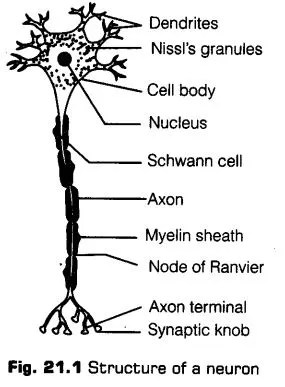
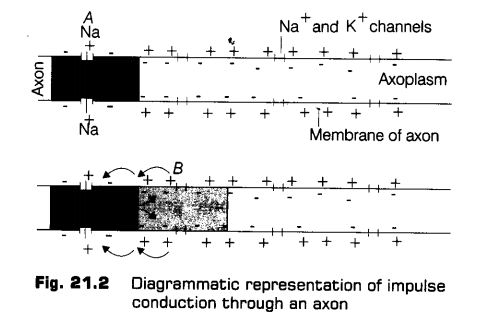
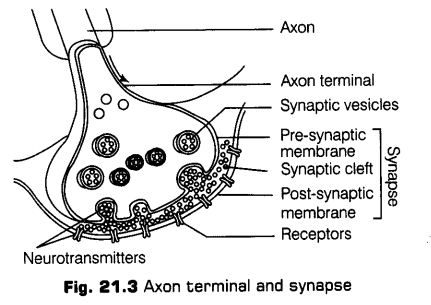
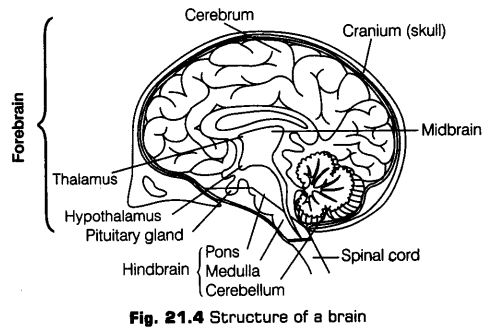
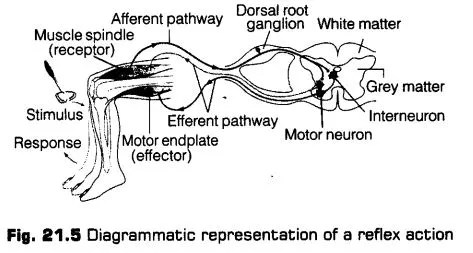
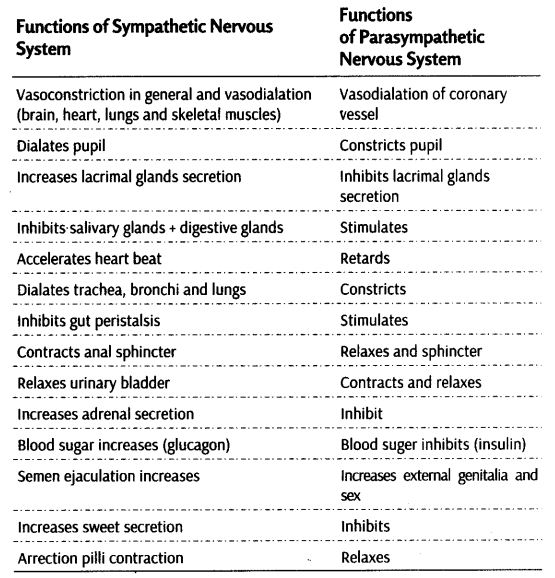
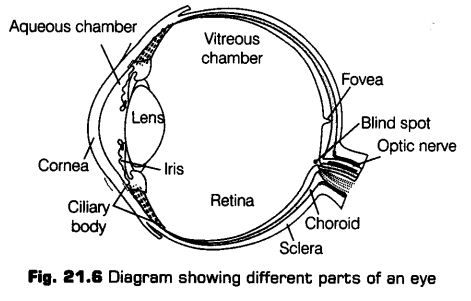
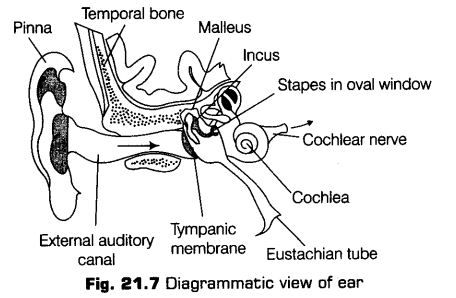
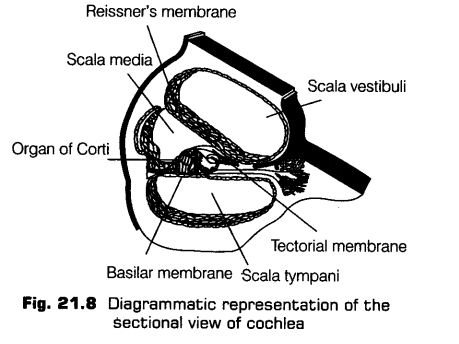
Leave a Reply